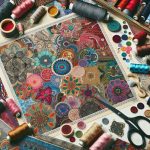Did you know that over 70% of modern fabric designs draw inspiration from the works of just a handful of renowned designers? When you explore the contributions of figures like William Morris, Zika Ascher, and Marimekko, you'll see how their unique approaches have set enduring trends in textile design. Morris's nature-inspired patterns, Ascher's bold innovations, and Marimekko's commitment to sustainability have collectively shaped the industry. Curious about the lasting influence of these creative minds and how they've changed the fabrics you encounter daily? Let's take a closer look at their remarkable legacies.
Table of Contents
Key Takeaways
- William Morris revolutionized 19th-century fabric design with intricate patterns and nature-inspired motifs.
- Zika Ascher's bold patterns and luxurious materials modernized textile design through innovative and artistic collaborations.
- Marimekko's iconic minimalist patterns and sustainable materials influenced global fashion and home decor.
- Vera Neumann's vibrant, nature-inspired designs transformed everyday items into creative canvases.
- Kaffe Fassett's use of bold colors and intricate designs encourages breaking traditional design boundaries.
William Morris
During the late 19th century, William Morris revolutionized fabric design with his intricate patterns and commitment to craftsmanship. You're probably familiar with his influence on textile innovations and timeless style.
Morris didn't just create beautiful fabrics; he transformed how people perceive them. His designs often drew artistic inspiration from nature motifs, featuring detailed representations of flora and fauna that brought the beauty of the natural world into everyday life.
Imagine owning a piece of fabric adorned with lush leaves, vibrant flowers, and intricate vines. That's the kind of timeless style Morris championed. His work wasn't just about aesthetics; it was about creating a harmonious blend of art and utility.
He believed that fabric design should evoke a sense of wonder and admiration, and you can see this philosophy in every piece he created.
Morris's dedication to craftsmanship meant that his fabrics weren't just visually stunning but also made to last. He used high-quality materials and traditional techniques, ensuring that his designs remained vibrant and durable.
Zika Ascher
Zika Ascher, a visionary in fabric design, captivated the fashion world with his innovative use of bold patterns and luxurious materials. You'd be amazed at how he transformed the textile industry with his groundbreaking approach. Ascher didn't just create fabrics; he pioneered textile innovation that left an indelible mark on fashion history.
Imagine Ascher collaborating with world-renowned artists like Henri Matisse and Henry Moore to produce stunning, artistic textiles. These collaborations didn't just elevate his fabrics but also solidified his fashion legacy. His intricate designs and vibrant colors became synonymous with high fashion, pushing boundaries and setting new standards.
You'll find that Ascher's contributions extend beyond mere aesthetics. He revolutionized the way textiles were perceived and used, blending art and fabric in ways that were previously unimaginable. His innovative spirit and relentless pursuit of excellence made him a key figure in the evolution of modern textile design.
In essence, Zika Ascher's impact on the fashion world can't be overstated. His commitment to textile innovation and his enduring fashion legacy continue to inspire designers and fashion enthusiasts alike. By studying Ascher's work, you'll gain invaluable insights into the transformative power of innovative design.
Marimekko's Legacy
When considering Marimekko's legacy, you'll see how their iconic patterns have evolved over the years while staying true to their bold, minimalist roots.
Their Scandinavian design philosophy emphasizes simplicity and functionality, which has left an indelible mark on global fashion.
You can't ignore how Marimekko's influence extends beyond textiles, shaping trends in home decor and lifestyle products worldwide.
Iconic Patterns Evolution
Marimekko's bold and innovative designs have revolutionized the world of fabric patterns since the 1950s. As you explore the iconic patterns evolution, you'll uncover how Marimekko has consistently influenced and transformed the design landscape. The brand's daring use of color and form has set a benchmark, inspiring countless modern interpretations. When you study Marimekko's pattern influences, you'll recognize how their fearless approach to design has enabled a seamless blend of art and functionality.
Consider the iconic Unikko (poppy) print, introduced in 1964 by Maija Isola. This pattern broke the mold, challenging conventional floral designs with its oversized, abstract blooms. It's an excellent example of how Marimekko's legacy has pushed boundaries and sparked creativity. Today, you'll see echoes of these foundational patterns in contemporary works, where designers reinterpret and adapt them to suit modern tastes and technologies.
Scandinavian Design Philosophy
Embedded in minimalism and functionality, Scandinavian design philosophy highlights crisp lines, natural materials, and a harmonious fusion of form and function. When you explore Marimekko's heritage, you'll uncover how this Finnish brand has skillfully embodied these principles.
Marimekko's designs often feature bold, uncomplicated patterns that mirror a minimalist style, avoiding unnecessary embellishments. You're probably familiar with Marimekko's iconic Unikko poppy print, which showcases their commitment to crafting visually striking yet straightforward designs.
By prioritizing sustainable materials, Marimekko guarantees that their fabrics aren't just aesthetically pleasing but also environmentally conscious. This dedication to sustainability aligns seamlessly with the broader Scandinavian mindset, where environmental awareness is crucial.
As you peruse Marimekko's diverse collections, you'll observe their constant use of organic cotton, linen, and recycled fibers. These choices demonstrate how Marimekko incorporates sustainable practices without sacrificing aesthetic appeal or quality. Their approach serves as a model for those aiming to produce impactful designs while remaining eco-friendly.
In essence, Marimekko's heritage in Scandinavian design stands as a tribute to the lasting influence of minimalism, sustainability, and functional sophistication.
Global Fashion Influence
Through bold designs and innovative creations, Marimekko has left an enduring mark on global fashion. You might find it fascinating that Marimekko's rise began in the 1950s, a period when the fashion industry was ripe for disruption. Their approach wasn't just about creating visually appealing textiles; it was about making a cultural impact.
By embracing vibrant colors and abstract shapes, they challenged the conventional aesthetics of the time, setting a new standard for trendsetting designers.
As you explore further, you'll notice Marimekko's global reach isn't limited to fashion runways. Their designs have infiltrated various facets of daily life, from home décor to lifestyle products. This widespread influence underscores Marimekko's ability to resonate with diverse audiences across the world.
You can't ignore the ripple effects—other designers have drawn inspiration, leading to a broader acceptance of bold, unconventional patterns in mainstream fashion.
The legacy of Marimekko is a proof of how a brand can transcend borders and become a global icon. By consistently pushing the boundaries, they've cemented their place not only in the fashion industry but also in the cultural fabric of society.
Liberty of London
You can't talk about fabric design without mentioning Liberty of London's rich history. Their evolving designs, especially the iconic floral patterns, have left a lasting mark on the industry.
Explore how these elements have shaped modern fabric trends and the brand's enduring legacy.
Historical Design Evolution
Liberty of London revolutionized fabric design in the late 19th century with its innovative patterns and use of vibrant colors. You'd be amazed at how this iconic brand harnessed textile innovation to set itself apart.
Drawing from a rich tapestry of cultural influences, Liberty's designs seamlessly blended elements from diverse traditions, creating fabrics that were both unique and timeless.
The late 1800s saw a surge in fabric trends that leaned heavily on bold, expressive motifs, and Liberty of London was at the forefront. With technological advancements in fabric production, they were able to experiment with intricate designs and high-quality dyes that guaranteed longevity and vibrancy.
You'll appreciate how they leveraged these advancements to craft textiles that were both aesthetically pleasing and durable.
Iconic Floral Patterns
Stepping into the world of Liberty, you're immediately captivated by their iconic floral patterns that have become synonymous with timeless elegance and creativity. These designs, deeply rooted in vintage inspirations, seamlessly blend traditional influences with modern interpretations.
Liberty's floral motifs aren't just patterns; they're an art form, meticulously crafted to evoke a sense of nostalgia while remaining relevant in contemporary trends.
You'll notice how Liberty doesn't shy away from embracing bold, vibrant colors and intricate details, making each fabric a masterpiece. The juxtaposition of contemporary trends with traditional influences is evident in their collections, where classic florals are reimagined for today's discerning clientele.
This innovative approach guarantees that Liberty's designs remain fresh and appealing, transcending generations.
Vera Neumann
Vera Neumann revolutionized textile design with her vibrant patterns and innovative approach. Her artistic legacy is built on a foundation of textile innovation and bold color exploration. As you explore her work, you'll notice how she seamlessly combined art and fashion, making everyday items like scarves and linens into canvases of creativity.
To truly appreciate Vera's contributions, consider these key aspects of her work:
- Bold Use of Color: Vera's fearless approach to color transformed mundane textiles into captivating pieces. Her palette ranged from bright, sunny yellows to deep, rich blues, creating a visual feast for the eyes.
- Nature-Inspired Designs: Drawing inspiration from the natural world, Vera's patterns often featured flora and fauna, bringing an organic feel to her creations. Her ability to translate the beauty of nature into textile art set her apart from her contemporaries.
- Accessibility and Popularity: Vera made high-quality design accessible to the masses. Her products weren't only luxurious but also affordable, enabling a wider audience to enjoy her artistic vision.
Tricia Guild
Tricia Guild, renowned for her vibrant and eclectic interior designs, has left an indelible mark on the world of fabric design. You've likely marveled at her ability to blend bold hues and intricate patterns, transforming any space into a dynamic canvas of creativity.
With a keen eye for color inspiration, Guild doesn't merely follow trends; she sets them. Her work is a masterclass in the interplay of color, texture, and form, pushing the boundaries of what's possible in fabric design.
Guild's approach to textile innovation is nothing short of revolutionary. She employs a unique fusion of traditional craftsmanship and contemporary techniques, resulting in fabrics that are both timeless and avant-garde. Her designs evoke a sense of daring elegance, challenging you to rethink conventional aesthetics.
When you explore Guild's portfolio, you'll discover an array of textiles that are as functional as they're beautiful. From opulent velvets to crisp linens, each piece is meticulously crafted to enhance both visual and tactile experiences.
Orla Kiely
While Tricia Guild dazzles with her bold color palettes, Orla Kiely captivates with her iconic retro-inspired patterns. Known for her distinctive approach, Kiely has become synonymous with the term 'Orla Kiely: Retro Revival.' Her work effortlessly blends 1960s and 1970s aesthetics with contemporary style, creating textiles that are both nostalgic and pleasantly modern.
Kiely's impact on the design world is profound, particularly in textile innovation. Her patterns often feature simple, repetitive motifs—think stylized leaves, flowers, and animals—that are instantly recognizable. These designs not only evoke a sense of nostalgia but also bring a playful elegance to modern interiors.
To better appreciate Orla Kiely's contributions, consider these key elements:
- Iconic Patterns: Kiely's designs are renowned for their geometric shapes and vibrant colors, making them a favorite among those looking to add a retro touch to their spaces.
- Versatility: Her textiles are used in a variety of applications, from home decor to fashion, demonstrating her broad influence.
- Sustainability: Kiely often incorporates eco-friendly materials and practices, aligning her retro revival with modern values.
Kaffe Fassett
Renowned for his vibrant use of color and intricate designs, Kaffe Fassett has left an indelible mark on the world of textile arts. When you explore Fassett's colorful creations, you can't help but feel a surge of artistic inspiration. His fabrics aren't just materials; they're vivid tapestries that tell stories, evoke emotions, and capture the essence of artistic freedom.
Fassett's journey began with an insatiable curiosity for color and texture, leading him to experiment with knitting, needlepoint, and quilting. His distinctive style, characterized by bold hues and complex patterns, challenges traditional notions of design. You'll notice that Fassett doesn't shy away from daring combinations; instead, he embraces them, creating a harmonious symphony of colors.
As you immerse yourself in Fassett's work, you'll discover that his designs invite you to break free from conventional palettes and explore the boundless possibilities of color. His influence extends beyond fabrics; his books and workshops have empowered countless artists to find their own voice.
If you're seeking to elevate your craft, studying Fassett's techniques and philosophies offers a treasure trove of insights that can transform your approach to textile artistry.
Anna Maria Horner
When you explore Anna Maria Horner's work, you can't help but notice her vibrant color palettes and unique pattern designs.
Her fabrics bring a fresh and energetic feel to any project.
You'll find her ability to mix bold colors with intricate patterns truly inspiring.
Vibrant Color Palettes
Anna Maria Horner's vibrant color palettes transform fabrics into dynamic works of art that captivate and inspire. By leveraging color psychology, she taps into emotional responses, creating designs that evoke joy, tranquility, and energy.
Her design inspiration often stems from nature, family, and her eclectic background, allowing her to craft unique combinations that resonate deeply with viewers. You can see how her mastery of hues and shades results in fabrics that don't just look beautiful but also tell a story.
Horner's work is notably influenced by various cultures, which she seamlessly integrates into her modern interpretations. These cultural influences give her fabrics a rich, global feel that appeals to a wide audience.
Whether she's drawing from the bold patterns of African textiles or the delicate motifs of Asian art, her color choices are always purposeful and impactful. This blend of tradition and contemporary design makes her fabrics versatile and timeless.
Consider how you can incorporate her vibrant color palettes into your own projects:
- Highlight focal points: Use bold colors to draw attention to specific areas.
- Create harmony: Balance vibrant hues with neutral tones.
- Evoke emotions: Choose colors based on the mood you want to set.
Unique Pattern Designs
Horner's unique pattern designs combine intricate details with bold motifs, creating textiles that stand out in any project. If you're aiming to master the art of fabric design, her work offers a perfect blend of modern interpretations and cultural inspirations. Each piece she creates is a demonstration of how contemporary trends can mesh seamlessly with traditional techniques.
When you explore Horner's collections, you'll notice how she draws from a rich tapestry of global cultures. This isn't just about borrowing elements; it's about transforming them into something fresh and innovative. Her patterns often feature a mix of geometric shapes, florals, and abstract forms, reflecting a deep understanding of both historical and modern design principles.
By studying Horner's approach, you can learn how to balance complexity with clarity. Her designs are intricate yet never overwhelming, a skill that sets her apart in the industry. She excels at using color and form to create depth and movement, inviting viewers to engage with the fabric on a deeper level.
Incorporating Horner's techniques into your own work can elevate your designs, making them not only visually striking but also culturally rich and timeless.
Tammis Keefe
Tammis Keefe, renowned for her vibrant and whimsical textile designs, left an indelible mark on the mid-20th century fabric industry. Her work embodied the essence of mid century modern aesthetics, capturing the era's playful and innovative spirit. You'd find that her whimsical illustrations brought an element of joy and sophistication to everyday household items, setting her apart from her contemporaries.
Keefe's influence can be seen in several key aspects:
- Innovative Patterns: She introduced groundbreaking designs that combined bold colors and intricate details, which were revolutionary at the time.
- Versatility: Her creations spanned across various mediums, including handkerchiefs, table linens, and kitchen textiles, proving her versatility and broad appeal.
- Cultural Impact: Keefe's designs often reflected contemporary themes and social trends, making her work not just decorative, but also culturally significant.
Her legacy continues to inspire modern designers who seek to blend artistic creativity with functional design. By studying Keefe's work, you'll gain insight into how to balance whimsy with practicality, ensuring that your designs are both aesthetically pleasing and utilitarian.
Embrace her innovative spirit, and you'll find endless possibilities in textile design.
Frequently Asked Questions
How Are Fabric Designs Traditionally Made Before Digital Tools?
Imagine a craftsman hand weaving intricate patterns, then using ancient dyeing techniques to add vibrant colors. Traditionally, you'd create fabric designs through meticulous manual processes, ensuring each piece was unique and showed high craftsmanship.
What Are the Environmental Impacts of Fabric Dyeing Processes?
You need to understand that fabric dyeing processes greatly contribute to water pollution and high energy consumption. These impacts harm ecosystems and deplete resources, so it's important to explore sustainable alternatives for minimizing environmental damage.
How Does Cultural Heritage Influence Modern Fabric Design?
Cultural influences shape modern fabric design by blending traditional motifs with modern techniques. You see this fusion in vibrant patterns and innovative textures, reflecting a rich heritage while pushing creative boundaries in contemporary fashion and home décor.
What Are Some Emerging Trends in Sustainable Fabric Production?
Did you know 73% of millennials are willing to pay more for sustainable products? In sustainable fabric production, the circular economy and eco-friendly materials are key trends, ensuring reduced waste and a smaller environmental footprint.
How Do Fabric Designers Collaborate With Fashion Designers?
You'll find fabric designers and fashion designers often engage in a collaborative process, where creative inspiration flows both ways. They innovate together, experimenting with textile manipulation to push the boundaries of design and create unique collections.
- How Does Ring Spun Cotton Affect Garment Fit and Shape Retention? - August 13, 2024
- What Are the Challenges in Producing Ring Spun Cotton? - August 13, 2024
- Is Ring Spun Cotton Suitable for Plus-Size Clothing? - August 13, 2024







